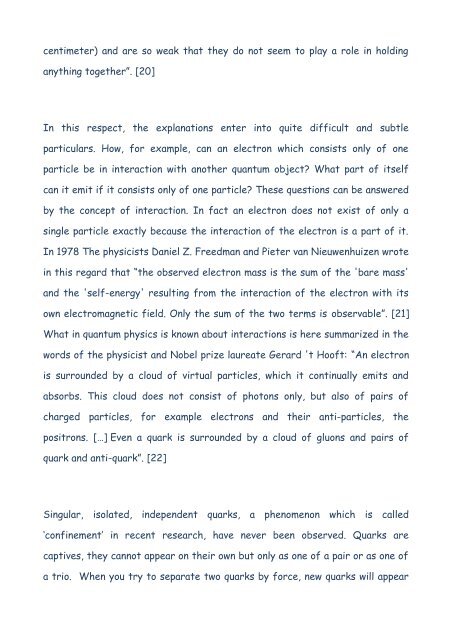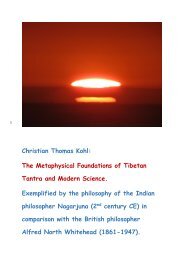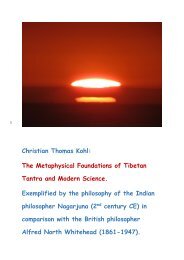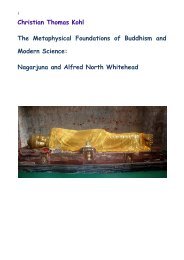Christian Thomas Kohl The Metaphysical Foundations of Buddhism and Modern Science
Christian Thomas Kohl The Metaphysical Foundations of Buddhism and Modern Science
Christian Thomas Kohl The Metaphysical Foundations of Buddhism and Modern Science
Create successful ePaper yourself
Turn your PDF publications into a flip-book with our unique Google optimized e-Paper software.
centimeter) <strong>and</strong> are so weak that they do not seem to play a role in holding<br />
anything together”. [20]<br />
In this respect, the explanations enter into quite difficult <strong>and</strong> subtle<br />
particulars. How, for example, can an electron which consists only <strong>of</strong> one<br />
particle be in interaction with another quantum object? What part <strong>of</strong> itself<br />
can it emit if it consists only <strong>of</strong> one particle? <strong>The</strong>se questions can be answered<br />
by the concept <strong>of</strong> interaction. In fact an electron does not exist <strong>of</strong> only a<br />
single particle exactly because the interaction <strong>of</strong> the electron is a part <strong>of</strong> it.<br />
In 1978 <strong>The</strong> physicists Daniel Z. Freedman <strong>and</strong> Pieter van Nieuwenhuizen wrote<br />
in this regard that “the observed electron mass is the sum <strong>of</strong> the 'bare mass'<br />
<strong>and</strong> the 'self-energy' resulting from the interaction <strong>of</strong> the electron with its<br />
own electromagnetic field. Only the sum <strong>of</strong> the two terms is observable”. [21]<br />
What in quantum physics is known about interactions is here summarized in the<br />
words <strong>of</strong> the physicist <strong>and</strong> Nobel prize laureate Gerard 't Ho<strong>of</strong>t: “An electron<br />
is surrounded by a cloud <strong>of</strong> virtual particles, which it continually emits <strong>and</strong><br />
absorbs. This cloud does not consist <strong>of</strong> photons only, but also <strong>of</strong> pairs <strong>of</strong><br />
charged particles, for example electrons <strong>and</strong> their anti-particles, the<br />
positrons. […] Even a quark is surrounded by a cloud <strong>of</strong> gluons <strong>and</strong> pairs <strong>of</strong><br />
quark <strong>and</strong> anti-quark”. [22]<br />
Singular, isolated, independent quarks, a phenomenon which is called<br />
‘confinement’ in recent research, have never been observed. Quarks are<br />
captives, they cannot appear on their own but only as one <strong>of</strong> a pair or as one <strong>of</strong><br />
a trio. When you try to separate two quarks by force, new quarks will appear


















